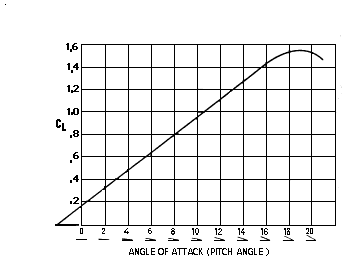Lift Formula
SUBJECT: Aeronautics
TOPIC: Lift
DESCRIPTION: A set of problems dealing with the aerodynamic lift equation.
CONTRIBUTED BY: Carol Hodanbosi
EDITED BY: Jonathan G. Fairman - August 1996
Purpose:
To understand for lift formula that determines aircraft lift
capabilities.
Concept:
An aircraft's lift capabilities can be measured from the following
formula:
L = (1/2) d v2 s CL
- L = Lift, which must equal the airplane's weight in
pounds
- d = density of the air. This will change due to
altitude. These values can be found in a I.C.A.O. Standard
Atmosphere Table.
- v = velocity of an aircraft expressed in feet per
second
- s = the wing area of an aircraft in square feet
- CL = Coefficient of lift , which is determined by the
type of airfoil and angle of attack.
The angle of attack and CL are related and can be found using a
Velocity Relationship Curve Graph (see Chart B below).
Exercises
- You are flying an F-117A fully equipped, which means that your
aircraft weighs 52,500 pounds. You want to maintain equilibrium in
straight and level flight at an altitude of 30,000 feet, cruising
at 400 knots to conserve fuel. The aircraft's wing area is 1,140
square feet. At what angle of attack should the F-117A be set to
maintain equilibrium?
** Additional information you need to know to solve this
problem:
How are knots related to mph to ft/s? See conversion below
What is air density at 30,000 feet? See following chart
(I.C.A.O.). chart A
What is the relationship between CL and angle of attack?
Use following Chart B to determine this value.

1 knot = 1 nautical mile per hour = 6,076 ft per hour
1 mph = 1 mile per hour = 5,280 feet per hour
(answer)
- To maintain an altitude of 45,000 feet at a constant speed
requires an angle of attack of 4° . Your F-22 weighs 56,450
pounds, with a wing area of 830 square feet. To stay in level
flight , what should your air speed indicate? The new F-22 air
speed is indicated in Mach speed, not in knots.
** Additional information you need to know to solve this
problem:
How does Mach speed convert from feet per second or from
knots?
An angle of attack of 4° converts to what CL?
What is the density of air at 45,000 feet?
Mach 1 is the speed of sound, which varies with the air
density. See the following I.C.A.O. chart (chart A) below. Mach 2
is twice the speed of sound, Mach 3 is three times the speed of
sound.
Use the Velocity Relationship Curve Graph chart below,
Chart B, to find the appropriate CL from the given
angle of attack.
(answer)
- At what velocity should you be traveling in the F-22 to
maintain an 0° angle of attack at an altitude of 42,000 feet? Your
weight is 57,600 pounds
(answer)
- Using the same plane (F-22) the same weight (57,600 pounds)
and angle of attack, what should be its cruising speed at 36,000 feet?
While descending from 42,000 feet to 36,000 feet the plane covers
a horizontal distance of 40 nautical miles. What is the decent
angle in degrees?
(answer)
Chart A
I.C.A.O. Standard Atmosphere Table
Altitude Density Speed of Sound
(Feet) (d) (Knots)
0 .002377 661.7
1,000 .002308 659.5
2,000 .002241 657.2
3,000 .002175 654.9
4,000 .002111 652.6
5,000 .002048 650.3
6,000 .001987 647.9
7,000 .001927 645.6
8,000 .001868 643.3
9,000 .001811 640.9
10,000 .001755 638.6
15,000 .001496 626.7
20,000 .001266 614.6
25,000 .001065 602.2
30,000 .000889 589.5
35,000 .000737 576.6
36,089* .000706 573.8
40,000 .000585 573.8
45,000 .000460 573.8
50,000 .000362 573.8
55,000 .000285 573.8
* Geopotential of Tropopause
Chart B
Velocity Relationship Curve Graph

Related Pages:
Aeronautics Activities
Aerospace Activities Page
Aerodynamics Index
Lift Equation
Lift Coefficient
Inclination Effects on Lift
Atmosphere Model
Mach Number
|
